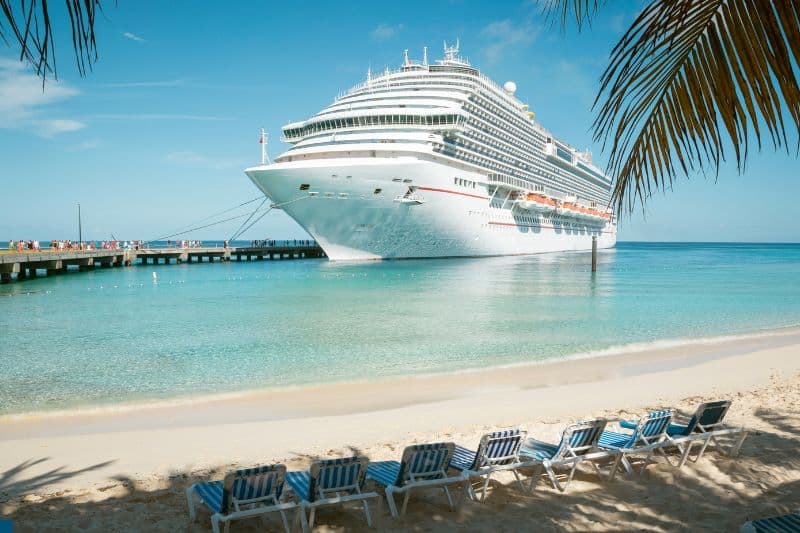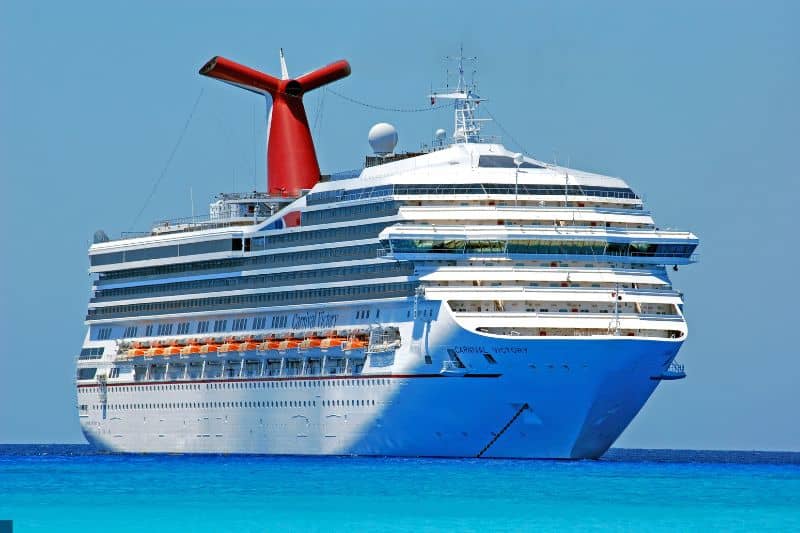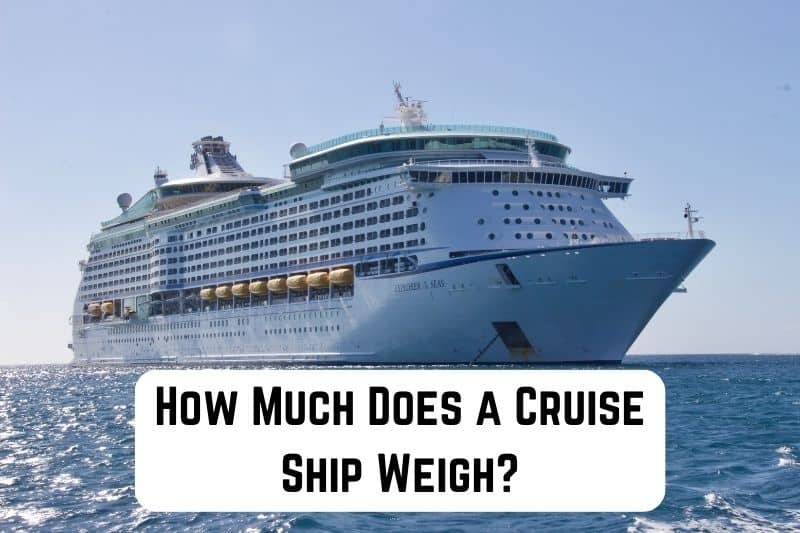When you think of cruise ships, you likely imagine massive floating cities that carry thousands of passengers. These impressive vessels are marvels of modern engineering, and their sheer size is enough to spark curiosity about how much they actually weigh. Understanding the weight of a cruise ship can help put their incredible size and capabilities into perspective.
A typical modern-day large cruise ship weighs around 200,000 gross tons. Gross tonnage is used to measure the weight of these enormous vessels, with one gross ton equaling 100 cubic feet of enclosed space. For comparison, the historic RMS Titanic weighed approximately 58,000 tons, a far cry from the behemoths that sail our oceans today.
The world’s largest cruise ships, such as the Harmony of the Seas, Allure of the Seas, and Oasis of The Seas, tip the scales at over 200,000 tons each. It’s amazing to think about how these colossal ships can effortlessly sail across the high seas, granting you a luxurious vacation experience without feeling weighed down by their immense size.
Read: How Much Does a Boeing 747 Weigh? (Explained)
A typical modern-day large cruise ship weighs around 200,000 gross tons. A small cruise ship weighs over 137,000 gross tons. Carnival Cruise Ships may weigh up to a staggering 220,000 tons, which is equivalent to 44,000 full-size cars!
Measuringly.com
Cruise Ship Basics
Cruise ships are impressive structures designed for extended periods at sea, offering various amenities and venues to guests on board. In this section, we will cover the basics of cruise ships, their types, and how their size and dimensions can affect your experience on board.
Types of Cruise Ships
There are different types of cruise ships, each catering to specific preferences and travel styles. Some of the most common types include:
- Ocean liners: These ships are built for long voyages across the ocean and are typically larger and more luxurious. They often have multiple dining venues, high-end amenities, and more spacious accommodations.
- River cruise ships: Smaller and more intimate, river cruise ships are specifically designed to navigate shallow waterways, such as rivers and canals. They offer a more relaxing and scenic experience, with fewer onboard entertainment options compared to ocean liners.
Expedition cruise ships: Designed for adventure-seeking travelers, expedition cruise ships are built to reach remote destinations like the Arctic or Antarctica. These vessels are equipped with onboard experts to lead explorations and are focused on providing enrichment and educational experiences.
Size and Dimensions
The size of a cruise ship greatly impacts the overall experience, influencing the number of passengers, amenities, and activities you can enjoy on board. Large and modern cruise ships typically weigh around 200,000 gross tons and can be over 1,000 feet in length.
The 50 biggest cruise ships today weigh over 100,000 tons each. To put that into perspective, the RMS Titanic weighed around 58,000 tons.
Larger ships often provide more entertainment options and space for passengers. However, they can also be more challenging to navigate, making it likely to encounter larger crowds at popular venues and during peak hours.
On the other hand, smaller ships provide a more intimate setting and can reach destinations that larger ships cannot access. Ultimately, your choice of cruise ship size will depend on your personal preferences and the experience you want on your journey.

Determining a Cruise Ship’s Weight
Cruise ships are massive structures that can easily weigh hundreds of thousands of tons. To determine a cruise ship’s weight, it’s essential to consider several factors, such as gross tonnage, displacement, and deadweight tonnage. In this section, we’ll discuss these factors so that you can better understand how the weight of a cruise ship is calculated.
Gross Tonnage
Gross tonnage is a measurement often used to describe a ship’s size. It’s important to note that gross tonnage is not a direct measure of a ship’s weight but rather its overall internal volume.
For example, the Oasis of the Seas weighs approximately 225,282 tons. To get an idea of a ship’s weight, you can use its gross tonnage as a rough estimation, bearing in mind that it doesn’t directly correlate to the actual weight.
Displacement
Displacement is the actual weight of a cruise ship, as it refers to the amount of water the ship displaces when it’s floating. To find the displacement, you’ll need to compare the ship’s weight when it’s empty (lightship) to its weight when it’s fully loaded with passengers, cargo, and fuel (load displacement).
The difference between the two weights indicates the ship’s actual weight. Unfortunately, displacement figures are often challenging to find, so knowing the gross tonnage may be more helpful as a starting point.
Deadweight Tonnage
Deadweight tonnage (DWT) is another term used when discussing a ship’s weight. DWT refers to the total carrying capacity of a ship, including passengers, cargo, fuel, and anything else on board. It’s the maximum amount of weight a ship can transport while maintaining its structural integrity and safety.
To calculate a ship’s DWT, you can subtract its lightship weight (the weight of the empty ship) from its load displacement (the weight when fully loaded). The resulting figure will give you the ship’s deadweight tonnage. Although it doesn’t provide the exact weight of a cruise ship, it can offer additional insight into the vessel’s overall weight and capacity.
In conclusion, understanding gross tonnage, displacement, and deadweight tonnage can provide a more comprehensive view of a cruise ship’s weight. Remember that these factors offer different perspectives on a ship’s overall size and capacity, and determining an exact weight may not always be straightforward.
Examples of Cruise Ship Weights
Smaller Cruise Ships
When it comes to cruise ships, the term “smaller” is relative. For instance, the Navigator of the Seas weighs over 137,000 gross tons, yet it is considered smaller compared to other ships in its class. You may encounter smaller cruise ships weighing around:
- 50,000 gross tons: Some ships fall in this range, offering a more intimate cruising experience.
- 75,000 to 100,000 gross tons: This category includes mid-sized ships with a balance of amenities and personalized service.
Keep in mind that even smaller cruise ships can still be incredibly impressive, with several decks and numerous facilities for entertainment, dining, and relaxation.
Read: How Much Does a Transmission Weigh: Guide For Car Enthusiasts
Larger Cruise Ships
As you move up in size, you’ll find the real giants of the industry. These larger cruise ships can weigh well over 200,000 gross tons and offer their passengers an extensive range of amenities and experiences. For example, the Harmony of the Seas weighs an impressive 226,963 tons and measures 1,188 feet in length.
Here are some examples of larger cruise ship weight classes:
- 200,000 to 225,000 gross tons: Ships such as the Oasis of the Seas and Allure of the Seas fall into this category.
- Over 225,000 gross tons: The heaviest cruise ship is the Harmony of the Seas, but even larger ships are being built.
One of the factors contributing to the increased weight of modern cruise ships is their propulsion systems, which have evolved to become more efficient and complex. In any case, you can expect vast amenities, activities, and experiences on these immense floating cities.
Factors Affecting Cruise Ship Weight
Materials and Construction
When considering the weight of a cruise ship, it’s important to take into account the materials and construction used to build them. You’ll find that different materials and construction techniques can have significant impacts on the overall weight.
For example, shipbuilders may use lighter materials, like aluminum or composite materials, to reduce weight and improve fuel efficiency. Additionally, the structural design and layout of a ship can also contribute to its overall weight.
Onboard Amenities
Another factor affecting the weight of a cruise ship is the onboard amenities. As you may know, modern ships are equipped with a wide range of features, including swimming pools, theaters, restaurants, and shops, which all add to the overall weight.
Luxury liners, in particular, are often designed with lavish amenities that may considerably increase the ship’s weight. It’s crucial to remember that the more amenities a ship has, the heavier it tends to be.
Passengers and Cargo
Lastly, the weight of passengers and cargo plays a significant role in determining a cruise ship’s overall weight. As the number of passengers and amount of cargo increase, so does the ship’s weight.
For instance, large cruise ships may hold up to 400,000 tons or more, and a significant portion of this weight is attributed to its passengers and their belongings, as well as the consumables, provisions, and other equipment required for the voyage.
Keep in mind that these factors are only a few of the many aspects that influence a cruise ship’s weight. By understanding how materials, onboard amenities, and passengers and cargo contribute to the overall weight, you can better appreciate the impressive engineering that goes into designing and constructing these massive vessels.

How Much Does a Carnival Cruise Ship Weigh?
Carnival Cruise Ships are truly impressive regarding their size and weight. As part of their diversified fleet, their ships have a range of weights. Each ship may weigh up to a staggering 220,000 tons, which is equivalent to 44,000 full-size cars! Imagine a massive structure that spans 855 feet long and stands 11 stories tall.
Passenger capacity also varies greatly among Carnival ships. Smaller vessels may carry around 2,600 guests, while their largest ship, the Carnival Celebration, can accommodate over 6,600 passengers. Carnival measures their ship sizes by gross tonnage, which often causes confusion among people who are not familiar with the terminology.
In addition to the Carnival Celebration, the Carnival Jubilee will set sail in late 2023, measuring an impressive 183,521 gross tons and carrying a maximum of 5,374 passengers. The wide variety of vessel sizes reflects the diverse needs and expectations of cruise-goers, ensuring that Carnival has something to offer for everyone.
Keep in mind that these numbers serve as a general guide and may not apply to every Carnival Cruise Ship out there. But one thing is certain: these gigantic and magnificent vessels are a testament to human engineering and design, providing unforgettable experiences.
How Much Does a Cruise Ship Anchor Weigh?
When you think about the massive size of a cruise ship, you might be curious about the size and weight of its anchors. Anchors are vital in keeping these enormous vessels stationary while in port or when stopping out at sea. So, let’s dive into the details of cruise ship anchors and their weight.
Typically, a cruise ship anchor weigh between 10 to 20 US tons (9,000 to 18,000 kilos). But it’s important to note that the anchor’s weight is directly proportional to the size of the vessel since larger and heavier ships require larger and heavier anchors 2.
Moreover, the anchor’s dimensions also play a crucial role; the average anchor size of a cruise ship ranges between 10-20 feet in length and 8-15 feet in width 2. Besides, most modern cruise ships are equipped with more than one anchor to maintain their position effectively.
Keep in mind that the anchor itself isn’t the only heavy component; the chains used with the anchor can be even heavier and are also a significant factor in holding a cruise ship’s position when anchored offshore 1.
Remember, a cruise ship anchor’s weight and size vary depending on the ship and its requirements. Yet, with these numbers in mind, you can now visualize the impressive engineering that goes into securing these gigantic vessels while they are out on the open seas.
What is the Weight of the Largest Cruise Ship?
When you think about the largest cruise ship in the world, it’s truly an engineering marvel. The size and weight of these vessels are difficult to fathom. You might be curious about the weight of the current largest cruise ship.
The Wonder of the Seas holds the title of the largest cruise ship in the world right now. It has a gross tonnage of 236,857. For context, the gross tonnage is a measure used to represent the overall size and internal volume of a ship, not its actual weight. However, the gross tonnage gives you an idea of how immense this vessel truly is.
The Wonder of the Seas stretches 362 meters (1,188 ft) in length and 64 meters (210 ft) in width. With the capacity to accommodate up to 6,988 passengers, it’s clear that this ship brings a whole new meaning to the concept of a floating city.
Large cruise ships are designed with several decks, comfortable living spaces, and a massive assortment of amenities and activities. As you journey across the ocean on these cutting-edge vessels, you can enjoy a unique experience that blends the coziness of a luxury hotel with the boundless freedom of traveling by sea.
Each cruise ship is constructed with a specific balance in mind, ensuring they are still safe, reliable, and enjoyable for passengers even as they reach colossal proportions.
So, now you know the impressive dimensions and gross tonnage of the largest cruise ship in the world, the Wonder of the Seas. As you plan your next getaway, remember that each cruise offers a unique opportunity to explore, unwind, and embrace the joy of life on the open sea. Enjoy your adventure on these marvels of modern engineering!
Read: How Much Does a Generator Weigh: Guide to Common Models
Weight of Some of the Most Popular Cruise Ships
When you think about the size of a cruise ship, it’s essential to consider its weight as well. There’s no doubt that modern-day cruise ships are massive, but just how heavy are some of the most popular ones? Let’s explore their weights to give you a better understanding.
A typical large cruise ship weighs around 200,000 GT (gross tons), and it’s essential to know that this measurement is not the same as standard tons. One gross registered ton (GRT) represents 100 cubic feet of enclosed space. Let’s take a closer look at the weight of some well-known cruise ships:
- Harmony of the Seas: This remarkable vessel is considered one of the largest and heaviest ships in the world, weighing over 226,000 GT.
- Allure of the Seas: Ranking closely alongside Harmony, the Allure of the Seas comes in at over 225,000 GT.
- Oasis of the Seas: A sister ship to the previous two, Oasis of the Seas, weighs a massive 225,000 GT.
- MSC Meraviglia: This sophisticated ship, launched by MSC Cruises, has a weight of over 171,000 GT.
- Quantum of the Seas: Rounding out this list, Quantum of the Seas, owned by Royal Caribbean International, comes in at 168,000 GT.
To put this into perspective, the infamous RMS Titanic weighed just around 58,000 tons. Today’s cruise ships are truly colossal in comparison!
Remember that a cruise ship’s weight is not the only metric to consider. Other factors, such as length, width, and height, also significantly affect each vessel’s overall size and capacity. But, understanding the weight of these popular cruise ships provides a fascinating insight into their astonishing scale.







